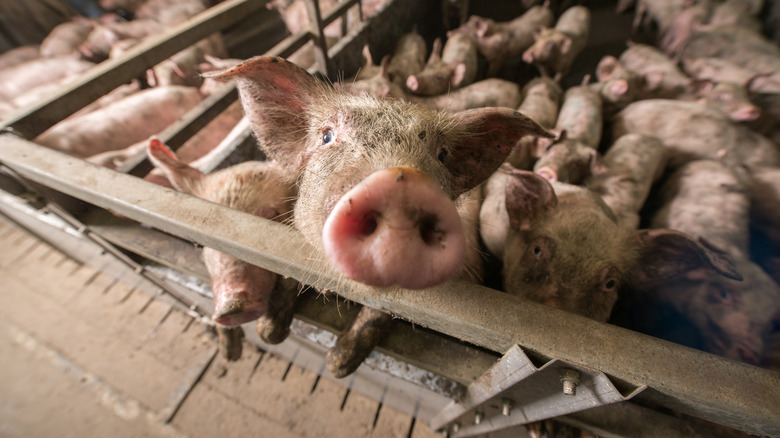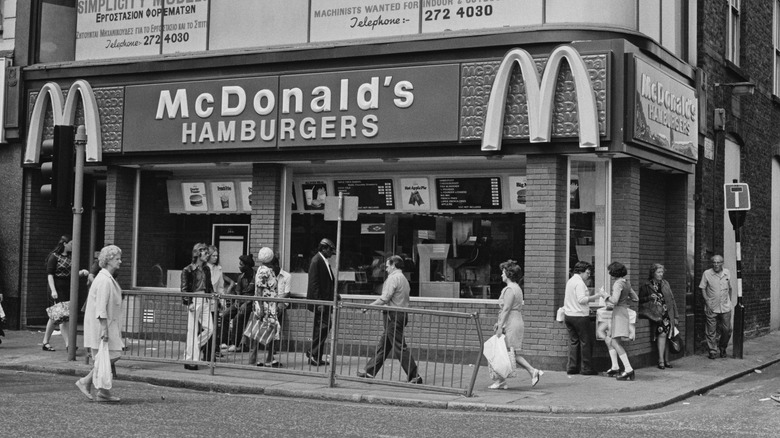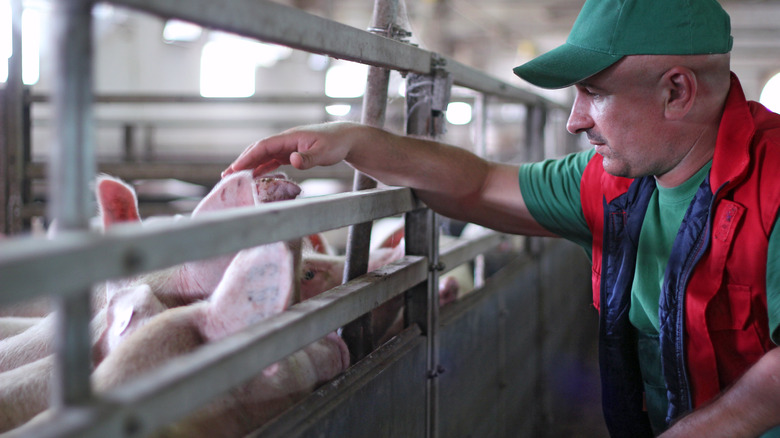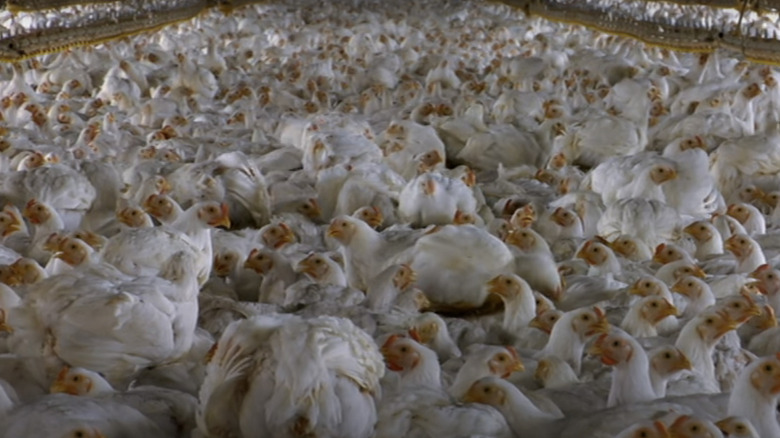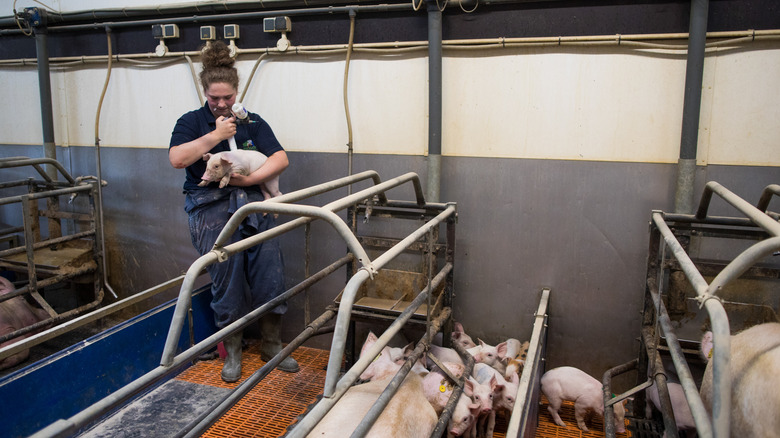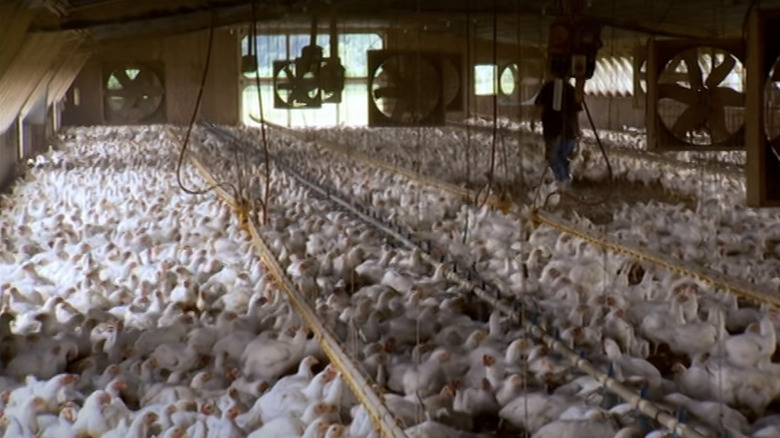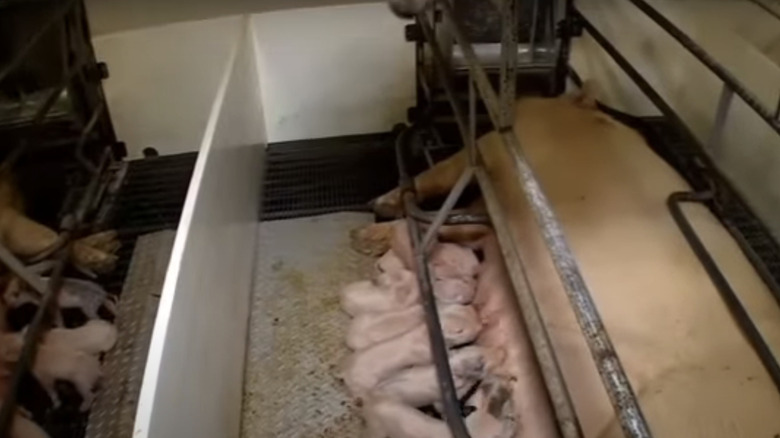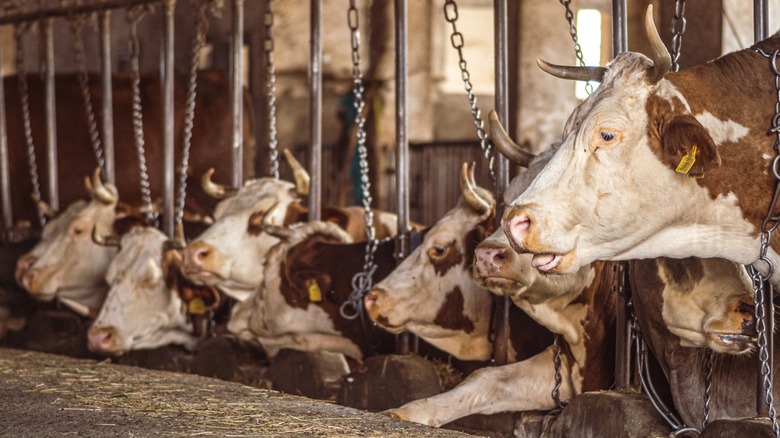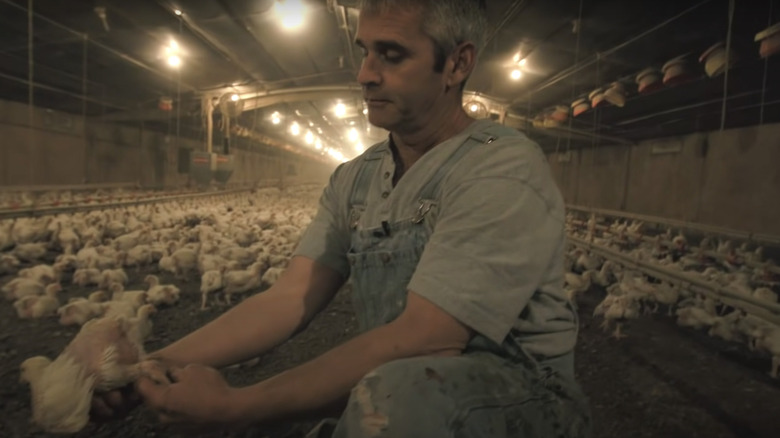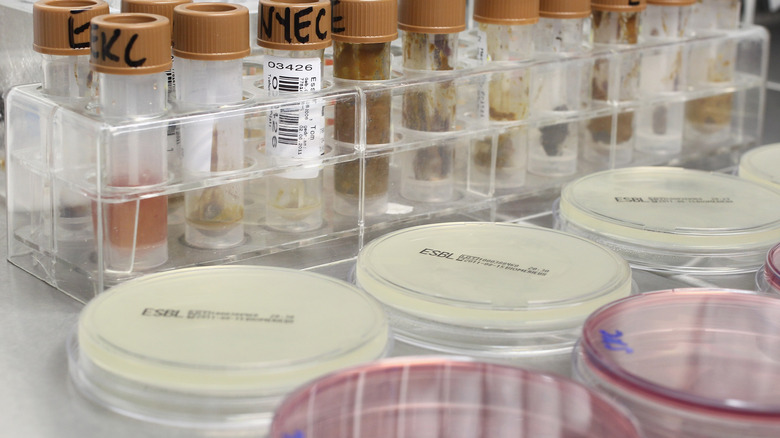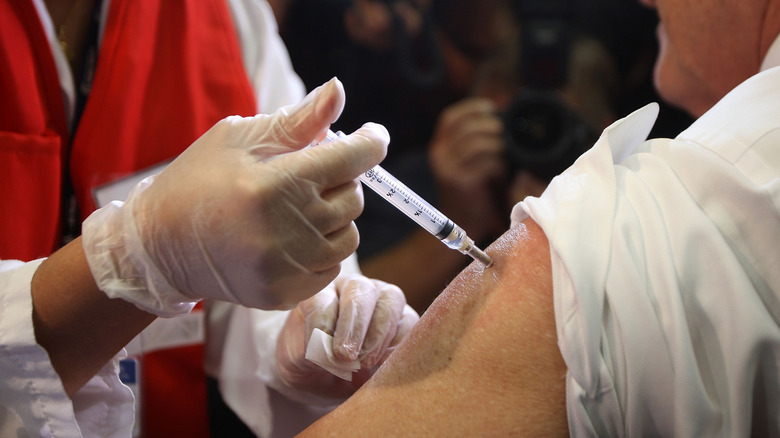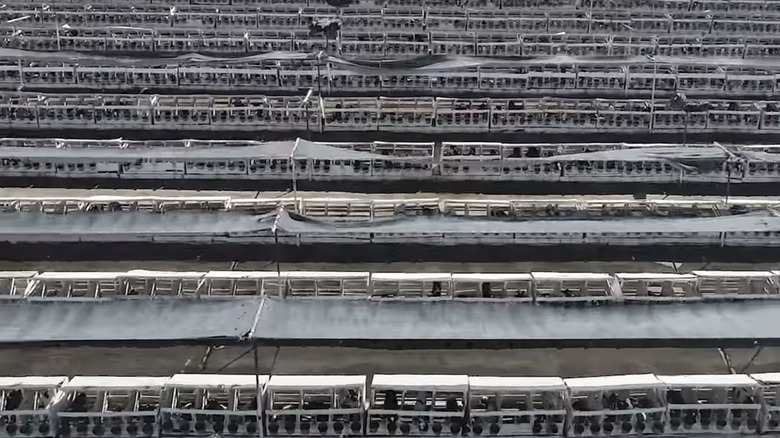The Dark Truth About Factory Farming
When most people picture farms, they probably imagine a red barn, a field with cows grazing and chickens running around, and a farmer in a straw hat riding on a tractor. This idyllic image is not an accident — it is promoted by brands in ads, logos, and packaging to make their products seem palatable, wholesome, and appetizing. In modern America, the places that food comes from do not resemble those old-fashioned farms at all. In reality, 99% of all animals raised for meat in the United States come from factory farms.
The term factory farm refers to an industrial facility that is run like a factory. The product they make on their assembly line is meat. The raw materials are living beings, human and animal. They are officially called CAFOs or concentrated/confined animal feeding operations. In these facilities, animals are packed into overcrowded cages with little ventilation. They are generally understaffed by underpaid workers to get the most meat at the cheapest prices onto supermarket shelves. They pass the savings along to the consumer at a price. Animals are abused, workers are exploited, and too often, diseases bred in these unsanitary facilities spill out into the general population.
Fast food transformed farms into factories
The beginnings of factory farms date back to the Industrial Revolution, and in 1904 Upton Sinclair famously went undercover as a worker in a Chicago meat processing plant, revealing the abysmal working conditions and repulsive practices around meat — the resulting expose was his famous 1906 novel "The Jungle." Although this prompted new regulations on food safety, the rise of factory-like facilities pumping out meat products was still to come. The main driver: McDonalds.
Many drive-in restaurants boomed in the 1930s, but as detailed in the documentary "Food, Inc.," McDonalds was unique because it could make food extremely cheaply and consistently. They achieved this by running their restaurants like factories, with assembly lines of unskilled workers making the exact same meals over and over again. This allowed them to pay workers far less than other restaurants. Today, McDonalds buys more ground beef than any other company in the U.S.
To support the ever-growing fast food industry, meat (and most other food) production became controlled by just a few massive corporations rather than individual local farms. These corporations formed to produce the massive quantity of food needed at the prices fast food companies demand, but today, the vast majority of available meat anywhere, from restaurants to supermarket shelves, comes from them. To produce so much meat so cheaply, quality, ethical standards, and sometimes food safety, are sacrificed.
Abusive working conditions
Working on a factory farm is grueling and dangerous work, and the corporations that run them demand that their workers produce a massive amount of meat fast, whatever the consequences.
Although working in a slaughterhouse is one of the most dangerous jobs in America, workers are paid meager wages, often making less than $25,000 a year while working 10-hour days watching animals being slaughtered. Injuries are common, and around eight slaughterhouse workers are killed every year. Employees at meatpacking facilities have reported being regularly shouted at and insulted by supervisors for falling behind schedule. Expectations for the workers are often impossible to achieve while maintaining safety standards, both for the employees and the customers. In 2013, an investigative reporter for VegNews went undercover at a Tyson chicken processing plant and described the horrendous conditions, stating, "The workers were actually urinating right on the equipment — on the poles and beneath the live-hanging conveyor belt that brought the birds in from outside." Work couldn't stop — even for a bathroom break.
Many of these exploited workers have little choice in their careers. Some prisons contract with factory forms, forcing people in prison to accept dangerous jobs there. Others are refugees or undocumented immigrants. According to a 2023 report from The New York Times, some meat processing plants including Tyson Foods and Perdue Farms are even under investigation for using child labor after an eighth grader's arm was mutilated by the machines while working for Perdue.
Horrific living conditions for animals
Many people know that factory farms keep animals in small spaces, but less know exactly how small those spaces truly are. Many chickens are kept in wire cages so small that they cannot open their wings all the way. As seen in the PBS documentary "Dirty Birds: A Story of Chickens in America," chickens are often kept in facilities so crowded that the birds are unable to reach their food and water, so they die. Female breeding pigs are kept in crates so small that they cannot turn around. These conditions are so bad that many animals are injured, develop sores, or get infections. They may also mutilate themselves or each other due to stress. To try to prevent this, many animals have their tails docked, horns removed, or beaks cut.
Even animals marked as "free range" may be living in horrific conditions. In leaked audio obtained by Vox, a farm manager and Tyson Foods technician described free range as a marketing ploy with no actual difference in how the chickens live. Currently, there is no legal definition of a free-range animal, which means that the standards vary wildly. The USDA's standard for free range simply states that the chickens must have access to the outdoors. As noted by Certified Humane, that does not mean that the door is large enough for chickens to actually get outside and doesn't mean that they aren't trapped in an overcrowded cage for their entire lives.
Factory farms are breeding new diseases
As described in a 2015 article in Public Health Ethics, the vast majority of strains of influenza began as bird and pig diseases before adapting to infect humans. The Spanish Flu, a devastating pandemic that spread around the world killing tens of millions of people in 1918, began in farm animals. Now, factory farms make it even easier for livestock to become a deadly petri dish for new epidemics. Factory farms pack hundreds and hundreds of stressed animals into confined spaces often with substandard hygiene practices. These conditions are the ideal breeding grounds for diseases of all kinds.
The idea that massive farms breed disease is nothing new. Factory farms were only able to become a booming business when antibiotics were discovered. Since 1938, dosing animals with antibiotics slowed the spread of these diseases -– but it can't keep up with modern factory farms. The level of stress factory farm animals are under weakens their immune systems. The lack of ventilation and sunlight lets viruses flourish while they find new hosts –- not that it will take long to find one. Keeping animals so close together makes it very easy for diseases and parasites to spread from animal to animal.
Animals have been changed by factory farming
"If breast meat is worth two dollars a pound and dark meat is worth one dollar, which would I rather have?" chicken meat titan Don Tyson once said (via The Guardian.) To speed up production and maximize output of the final product –- meat –- the corporations that run factory farms have physically changed the species that they raise and slaughter. While selective breeding is nothing new, chickens have gone through a particularly astonishing metamorphosis in a very short period of time.
As detailed in the documentary Food, Inc., chickens raised for meat in 2008 grew to be twice the size of chickens raised in 1950, and they took more than three weeks less time to do it. These new, fatter chickens are also larger-breasted than any before because most humans prefer to eat breast meat.
Sometimes, these animals no longer look like the ones most people picture when they imagine a farm animal. As described by the PBS documentary "Dirty Birds," a faster, fatter bird is not a healthier bird. Many have only sparse feathers because they are bred only for weight. Many of the chickens in modern farming have genetic issues that impact their joints, make them prone to infection, and force farmers to euthanize them.
Pigs lead short, brutal lives
Pigs are social animals that are as smart as dogs and can live between 15-20 years. When a pig is born in a factory farm, however, it is destined for slaughter, and its life leading up to that death is short, lonely, and grim.
Piglets are born to breeding sows, female pigs who are held in crates so small that they cannot turn around. When the piglets are born, the sow's cage becomes even smaller, forcing her to lie on her side so that the piglets have access to her nipples while being kept in the crate beside her. She is unable to interact with her babies.
The baby pigs have their ears notched, which is a process of cutting slices out of their ears on both sides so they can be easily identified by workers. The conditions in factory farms are stressful and unnatural for pigs, which leads to aggression. To keep them from biting off each other's tails, many factory farms simply cut off the tails of the pigs shortly after birth. When the piglets are considered large enough, several weeks later, the mother returns to her gestation crate to create another litter. This cycle will continue for about four years, after which she will be slaughtered. The babies are slaughtered at 6-10 months old.
Mother cows have endless calves taken from them
In the U.S., more than 70% of all cows live in factory farms. Many of these massive facilities hold thousands and thousands of cows. While millions of cows are killed for meat every year in America, the lives of dairy cows are just as dark.
Like many humans, mother cows immediately bond with their calves when they are born. If they are separated from their babies, they have been known to travel miles searching for them, and when trapped, they will bellow and cry loudly for weeks. In factory dairy farms, all calves are taken away from mother cows just a few hours after they are born. The mother cows are repeatedly impregnated so that they will always be producing milk and baby cows that she will never be able to raise. When their bodies give out, they are slaughtered on the dairy farm or sent out to a slaughterhouse where their bodies become low-quality meat products like ground beef.
Farmers are forced to follow inhumane practices
Instead of owning their own independent farms, many who seem to run their own farms today are actually contractors working for major corporations. For chicken farmers, or contract poultry growers, that means working for companies like Perdue and Tyson, whose policies are designed to lower their own costs at the expense of both their contractors and the animals.
In an interview in the PBS documentary "Dirty Bird," Perdue contractor Craig Watts explained that the company controls how the animals are raised and mandates that he keep them in an unventilated overcrowded silo. In "Food, Inc."one Tyson contractor stated that his 300,000 chickens never see daylight, while another Perdue grower described the facilities she was required to provide as covered in feces and dust, stocked with genetically disabled chickens that can barely walk.
One of the requirements is that the chickens who are unhealthy be euthanized by manual cervical dislocation, or grabbing the bird's head and twisting so the skull is separated from the spinal column. In the interview Watts demonstrated this method, and, while looking at the desperately flapping chicken, expressed doubts about whether it could really be as painless as he had been told. Multiple contracted farmers have expressed frustration at the number of chickens, provided by the companies, that die or need to be euthanized, costing them money and forcing them to deal with the bodies of dead animals daily.
Unsanitary practices contaminate meat, water, and produce
Confined animal feeding operations are designed to produce meat, and as their official name implies, that involves feeding potentially thousands of animals. The standard food of choice for cows is corn, because there is a lot of it and it can be produced cheaply. Unfortunately, cows have evolved to eat grass, not corn, and having a diet entirely of something that is not their natural food source has had dire consequences: E Coli. This new strain of disease lives in the guts of livestock like cows and can contaminate anything their waste touches.
Many animals in factory farms are in highly unsanitary conditions, and many cows are standing in deep manure all day, every day. Regularly being covered in their own feces and the feces of other cows allowed the disease to jump easily from animal to animal. As described in "Food, Inc.," it is not uncommon for animals to still be covered in feces when they are slaughtered, meaning that some of it gets into the meat, so diseases spread to consumers.
Unsanitary conditions in factory farms don't just impact people who eat the contaminated meat. This massive amount of manure doesn't stay in the CAFO. Instead, it seeps into the ground and is washed away by rain. This runoff can and has contaminated water sources and leafy vegetable crops, causing deadly outbreaks in humans.
Pandemics can come from factory farms
In 2009, the world grappled with the H1N1 pandemic that killed between 150,000 and 575,000 people. Although it only became a problem for humans in 2009, it had been detected in pigs as long ago as 1920. Factory farming is believed to have allowed it to boom.
According to Gregory Gray, director of the Center for Emerging Infectious Diseases at the University of Iowa College of Public Health, in a 2009 article about H1N1 in Environmental Health Perspectives, respiratory viruses in factory farms are regularly introduced to new animals that haven't been exposed before, allowing them to replicate and mutate. When farm workers and veterinarians interact with animals with these new viruses, there is a potential for it to pass to humans for the first time. Then, when those workers go out into the world and interact with other people, the disease spreads in the human population.
It's unknown exactly when the "swine flu" as it came to be known made the leap from pigs to humans, but once it did, it was there to stay. As stated by the Mayo Clinic, although the pandemic officially ended in 2010, the disease never went away, and now is one of the strains of seasonal flu that can return to infect people every year.
It's one of the driving forces behind the climate crisis
CAFOs create a life of devastating horror for the animals who are born, live, and die inside them and an exploitative nightmare for the people who have to work in the system, but factory farming has wider ramifications for all life on Earth. The United Nations has reported that around one-third of all human-caused greenhouse gasses come from food production. Meat production is the worst offender.
Factory farms emit a massive amount of methane from the digestive systems of the animals housed there, especially cows. The carbon footprint of beef is absolutely massive. Nitrous oxide comes from fertilizers used to farm the massive amount of crops needed to feed the billions of animals in factory farms, especially corn and soy.
Disturbingly, much of this pollution is unregulated. For example, the Environmental Protection Agency has estimated that agriculture is the biggest contaminator of rivers and streams in the U.S., partially due to the massive amount of manure runoff coming from factory farms -– but it is exempt from the 1972 Clean Water Act. While most industries that pollute the environment and contribute to the climate crisis are regulated in the U.S., industrial animal agriculture is largely allowed to operate unchecked.
